All Exams >
CLAT >
4 Months Preparation Course for CLAT UG >
All Questions
All questions of Syllogism for CLAT Exam
In each of the questions below are given four statements followed by for conclusions numbered I, II, III and IV. You have to take given statements to be true even if they seem to be at variance from commonly known facts. Read all the conclusions and then decide which of the given conclusion logically follows from the given statements disregarding commonly known facts.
Q.
Statements :
No cream is a lemon.
All lemons are onions.
All cream is a grapes.
Conclusion :
(i) Some grapes are not onions.
(ii) All lemons are grapes is a possibility
- a)If only conclusion I follows;
- b)If only conclusion II follows;
- c)If either I or II follows;
- d)If neither I nor II follows; and
- e)If both I and II follow
Correct answer is option 'D'. Can you explain this answer?
In each of the questions below are given four statements followed by for conclusions numbered I, II, III and IV. You have to take given statements to be true even if they seem to be at variance from commonly known facts. Read all the conclusions and then decide which of the given conclusion logically follows from the given statements disregarding commonly known facts.
Q.
Statements :
Q.
Statements :
No cream is a lemon.
All lemons are onions.
All cream is a grapes.
Conclusion :
(i) Some grapes are not onions.
(ii) All lemons are grapes is a possibility
a)
If only conclusion I follows;
b)
If only conclusion II follows;
c)
If either I or II follows;
d)
If neither I nor II follows; and
e)
If both I and II follow

|
Shivshankar Shaw answered |
Ans is D because all cream is grapes and no cream is lemon so no possibility is all lemons are grapes
In the questions below are given four statements followed by for conclusions numbered I, II, III and IV. You have to the take given statements to be true even if they seem to be at variance from commonly known facts. Read all the conclusions and then decide which of the given conclusion logically follows from the given statements disregarding commonly known facts.
Q.
Statements:
Some chairs are tables.
All tables are pots.
All pots are mats.
Some mats are buses.
Conclusions:
I. Some buses are tables.
II. Some mats are chairs.
III. No bus is tables.
IV. Some mats are tables.
- a)I, II and IV follow
- b)II, III and IV follow
- c)Either I or III and II follow
- d)Either I or III and IV follow
- e)Either I or III and II and IV follow
Correct answer is option 'A'. Can you explain this answer?
In the questions below are given four statements followed by for conclusions numbered I, II, III and IV. You have to the take given statements to be true even if they seem to be at variance from commonly known facts. Read all the conclusions and then decide which of the given conclusion logically follows from the given statements disregarding commonly known facts.
Q.
Statements:
Some chairs are tables.
All tables are pots.
All pots are mats.
Some mats are buses.
Statements:
Some chairs are tables.
All tables are pots.
All pots are mats.
Some mats are buses.
Conclusions:
I. Some buses are tables.
II. Some mats are chairs.
III. No bus is tables.
IV. Some mats are tables.
a)
I, II and IV follow
b)
II, III and IV follow
c)
Either I or III and II follow
d)
Either I or III and IV follow
e)
Either I or III and II and IV follow

|
Aradhana Shukla answered |
A is correct answer
Statements :Some trees one are mangoes.All mangoes are bananas.All tomatoes are bananas.Conclusions:(i) All trees are tomatoes is a possibility.(ii) No bananas are tree is a possibility.- a)if only conclusion I follows;
- b)if only conclusion II follows;
- c)if either I or II follows;
- d)if neither I nor II follows; and
- e)if both I and II follow
Correct answer is option 'A'. Can you explain this answer?
Statements :
Some trees one are mangoes.
All mangoes are bananas.
All tomatoes are bananas.
Conclusions:
(i) All trees are tomatoes is a possibility.
(ii) No bananas are tree is a possibility.
a)
if only conclusion I follows;
b)
if only conclusion II follows;
c)
if either I or II follows;
d)
if neither I nor II follows; and
e)
if both I and II follow
|
|
Faizan Khan answered |
The answer is A because some mangoes are trees and all mangoes are bananas so some mangoes which are tree would come into bananas always hence conclusion II is not implicit.
Statements :All dusters are bowls.All bowls are shoes.No shoe is a root.All roots are flowers.Q. Conclusions :(i) No flower is a bowl.(ii) All dusters are shoes.- a)if only conclusion I follows;
- b)if only conclusion II follows;
- c)if either I or II follows;
- d)if neither I nor II follows; and
- e)if both I and II follow
Correct answer is option 'B'. Can you explain this answer?
Statements :
All dusters are bowls.
All bowls are shoes.
No shoe is a root.
All roots are flowers.
Q. Conclusions :
(i) No flower is a bowl.
(ii) All dusters are shoes.
a)
if only conclusion I follows;
b)
if only conclusion II follows;
c)
if either I or II follows;
d)
if neither I nor II follows; and
e)
if both I and II follow
|
|
Anaya Patel answered |
It is clear from the venn diagram that both the conclusions follow.
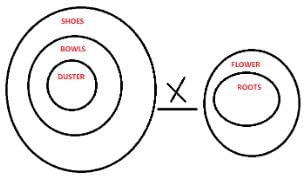

In each of the questions below are given four statements followed by for conclusions numbered I, II, III and IV. You have to the take given statements to be true even if they seem to be at variance from commonly known facts. Read all the conclusions and then decide which of the given conclusion logically follows from the given statements disregarding commonly known facts.Q. Statements: All birds are horses. All horses are tigers. Some tigers are lions. Some lions are donkey.Conclusions: I. Some tigers are horses.II. Some donkeys are birds.III. Some tigers are birds.IV. Some donkeys are horses.- a)I and III follow
- b)I, II and III follow
- c)II, III and IV follow
- d)All I, II, III and IV follow
- e)None of the above
Correct answer is option 'A'. Can you explain this answer?
In each of the questions below are given four statements followed by for conclusions numbered I, II, III and IV. You have to the take given statements to be true even if they seem to be at variance from commonly known facts. Read all the conclusions and then decide which of the given conclusion logically follows from the given statements disregarding commonly known facts.
Q. Statements: All birds are horses. All horses are tigers. Some tigers are lions. Some lions are donkey.
Conclusions:
I. Some tigers are horses.
II. Some donkeys are birds.
III. Some tigers are birds.
IV. Some donkeys are horses.
a)
I and III follow
b)
I, II and III follow
c)
II, III and IV follow
d)
All I, II, III and IV follow
e)
None of the above
|
|
Kiran Reddy answered |
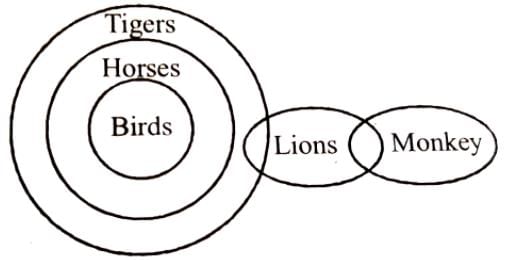
Conclusions:
I. True
II. False
III. True
IV. False
So, only conclusion I & III follow
I. True
II. False
III. True
IV. False
So, only conclusion I & III follow
In each of the questions below are given three statements followed by three or more conclusions. You have to take the given statements to be true even if they seem to be at variance with the commonly known facts.Statements:Some bricks are gates.
Some gates are roof.
All wheels are bricks.Conclusions:I. Some wheels are gates.II. No gate is wheelIII. Some gates are bricks.IV. All roof are bricks.- a)All follow
- b)Only either I or III follows.
- c)Only II follows.
- d)Only either I or II and III follow
Correct answer is option 'D'. Can you explain this answer?
In each of the questions below are given three statements followed by three or more conclusions. You have to take the given statements to be true even if they seem to be at variance with the commonly known facts.
Statements:
Some bricks are gates.
Some gates are roof.
All wheels are bricks.
Some gates are roof.
All wheels are bricks.
Conclusions:
I. Some wheels are gates.
II. No gate is wheel
III. Some gates are bricks.
IV. All roof are bricks.
a)
All follow
b)
Only either I or III follows.
c)
Only II follows.
d)
Only either I or II and III follow
|
|
Dia Mehta answered |
D is the correct option. a and b both are possible conclusions.. either a or b and it follows 3 as some bricks are gates therefore there is a clear probability of some gates are bricks.
In the questions below are given four statements followed by for conclusions numbered I, II, III and IV. You have to take given statements to be true even if they seem to be at variance from commonly known facts. Read all the conclusions and then decide which of the given conclusions logically follows from the given statements disregarding commonly known facts.
Q.
Statements:
All cups are bottles.
Some bottles are mugs.
No mug is a plate.
Some plates are tables.
Conclusions:
I. Some tables are bottles.
II. Some plates are cups
III. No table is a bottle.
IV. Some mugs are cups.
- a)Only I follows
- b)Only II follows
- c)Only III and || follows
- d)Only IV follows
- e) only III follows
Correct answer is option 'E'. Can you explain this answer?
In the questions below are given four statements followed by for conclusions numbered I, II, III and IV. You have to take given statements to be true even if they seem to be at variance from commonly known facts. Read all the conclusions and then decide which of the given conclusions logically follows from the given statements disregarding commonly known facts.
Q.
Statements:
All cups are bottles.
Some bottles are mugs.
No mug is a plate.
Some plates are tables.
Statements:
All cups are bottles.
Some bottles are mugs.
No mug is a plate.
Some plates are tables.
Conclusions:
I. Some tables are bottles.
II. Some plates are cups
III. No table is a bottle.
IV. Some mugs are cups.
a)
Only I follows
b)
Only II follows
c)
Only III and || follows
d)
Only IV follows
e)
only III follows

|
Harshitha Datta answered |
The Venn diagram for the syllogism is as shown below:
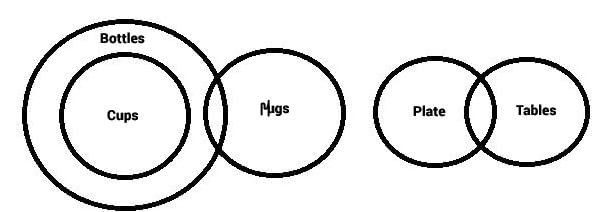
The conclusions I and III are complementary in nature ie. One of the two has to be correct universally and both can't be correct at the same time. And the other conclusions are false. Hence, option (E) is the right asnwer.
Statements :All mobiles are cellular.All cellular are machanics.All microphones are mobiles.Q. Conclusions :(i) Some machanics which one mobiles are also a part of microphones.(ii) All microphones are cellular.- a)if only conclusion I follows;
- b)if only conclusion II follows;
- c)if either I or II follows;
- d)if neither I nor II follows; and
- e)if both I and II follow
Correct answer is option 'E'. Can you explain this answer?
Statements :
All mobiles are cellular.
All cellular are machanics.
All microphones are mobiles.
Q. Conclusions :
(i) Some machanics which one mobiles are also a part of microphones.
(ii) All microphones are cellular.
a)
if only conclusion I follows;
b)
if only conclusion II follows;
c)
if either I or II follows;
d)
if neither I nor II follows; and
e)
if both I and II follow
|
|
Kiran Reddy answered |
The correct option is E.
It is clear from the venn diagram.
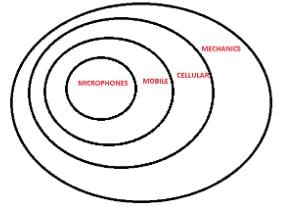
It is clear from the venn diagram.

Directions : In each question below are given two Statements: followed by two conclusion numbered I and II. You have to take the two given statement to be true even if they seem to be at variance with commonly known facts and then decide which of the given Conclusions: logically follows from the two given statement, disregarding commonly know facts.
Statements:
Some crows are jackals.
No fox is crow.
Conclusions:
I. Some jackals are foxes.
II. Some jackals are not foxes.
- a) if only conclusion I follows;
- b) if only conclusion II follows;
- c) if either I and II follows
- d)both I and II follow.
Correct answer is option 'C'. Can you explain this answer?
Directions : In each question below are given two Statements: followed by two conclusion numbered I and II. You have to take the two given statement to be true even if they seem to be at variance with commonly known facts and then decide which of the given Conclusions: logically follows from the two given statement, disregarding commonly know facts.
Statements:
Some crows are jackals.
No fox is crow.
Conclusions:
I. Some jackals are foxes.
II. Some jackals are not foxes.
a)
if only conclusion I follows;
b)
if only conclusion II follows;
c)
if either I and II follows
d)
both I and II follow.
|
|
Dia Mehta answered |
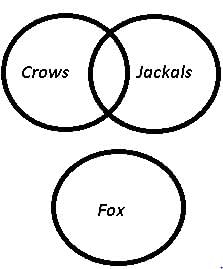
Conclusion:
I. Some jackals are foxes. = may or may not be true
II. Some jackals are not foxes. = may or may not be true
Directions : In each question below are given two Statements: followed by two conclusion numbered I and II. You have to take the two given statement to be true even if they seem to be at variance with commonly known facts and then decide which of the given Conclusions: logically follows from the two given statement, disregarding commonly know facts.Statements: A graduate is a man. This thief is a graduate.Conclusions: I. This thief is a man. II. Some men are thieves.- a) if only conclusion I follows;
- b) if only conclusion II follows;
- c) if neither I nor II follows; and
- d) if both I and II follow.
Correct answer is option 'D'. Can you explain this answer?
Directions : In each question below are given two Statements: followed by two conclusion numbered I and II. You have to take the two given statement to be true even if they seem to be at variance with commonly known facts and then decide which of the given Conclusions: logically follows from the two given statement, disregarding commonly know facts.
Statements:
A graduate is a man.
This thief is a graduate.
Conclusions:
I. This thief is a man.
II. Some men are thieves.
a)
if only conclusion I follows;
b)
if only conclusion II follows;
c)
if neither I nor II follows; and
d)
if both I and II follow.
|
|
Anaya Patel answered |
D is the correct option.in this question statement implies that a graduate is a man and a man is a thief. The assumption is this thief would be man or some thieves would be man. So both conclusions are follows.
Directions : In each question below are given two Statements: followed by two conclusion numbered I and II. You have to take the two given statement to be true even if they seem to be at variance with commonly known facts and then decide which of the given Conclusions: logically follows from the two given statement, disregarding commonly know facts. Give Answer:1) if only conclusion I follows;2) if only conclusion II follows;3) if neither I nor II follows; and4) if both I and II follow.Q. Statements: Men are sinners. Saints are men. Conclusions: I. Saints are sinners. II. Sinners are saints- a)1
- b)2
- c)3
- d)4
Correct answer is option 'A'. Can you explain this answer?
Directions : In each question below are given two Statements: followed by two conclusion numbered I and II. You have to take the two given statement to be true even if they seem to be at variance with commonly known facts and then decide which of the given Conclusions: logically follows from the two given statement, disregarding commonly know facts. Give Answer:
1) if only conclusion I follows;
2) if only conclusion II follows;
3) if neither I nor II follows; and
4) if both I and II follow.
Q. Statements:
Men are sinners.
Saints are men.
Conclusions:
I. Saints are sinners.
II. Sinners are saints
a)
1
b)
2
c)
3
d)
4
|
|
Divisha rane answered |
Given Statements:
- Men are sinners.
- Saints are men.
Conclusion I: Saints are sinners.
Conclusion II: Sinners are saints.
To determine if the given conclusions logically follow from the given statements, we need to examine the relationship between the terms used in the statements.
Analysis:
- Statement 1: Men are sinners. This implies that all men are sinners.
- Statement 2: Saints are men. This implies that all saints are a subset of men.
Conclusion I: Saints are sinners.
This conclusion does not logically follow from the given statements. Just because all men are sinners and all saints are men, it does not mean that all saints are sinners. It is possible for some men to be saints who lead a virtuous life and are not sinners.
Conclusion II: Sinners are saints.
This conclusion also does not logically follow from the given statements. Just because all saints are men and all men are sinners, it does not mean that all sinners are saints. It is possible for some men to be sinners who do not lead a virtuous life and are not saints.
Therefore, neither Conclusion I nor Conclusion II follows from the given statements.
Hence, the correct answer is option 3) neither I nor II follows.
- Men are sinners.
- Saints are men.
Conclusion I: Saints are sinners.
Conclusion II: Sinners are saints.
To determine if the given conclusions logically follow from the given statements, we need to examine the relationship between the terms used in the statements.
Analysis:
- Statement 1: Men are sinners. This implies that all men are sinners.
- Statement 2: Saints are men. This implies that all saints are a subset of men.
Conclusion I: Saints are sinners.
This conclusion does not logically follow from the given statements. Just because all men are sinners and all saints are men, it does not mean that all saints are sinners. It is possible for some men to be saints who lead a virtuous life and are not sinners.
Conclusion II: Sinners are saints.
This conclusion also does not logically follow from the given statements. Just because all saints are men and all men are sinners, it does not mean that all sinners are saints. It is possible for some men to be sinners who do not lead a virtuous life and are not saints.
Therefore, neither Conclusion I nor Conclusion II follows from the given statements.
Hence, the correct answer is option 3) neither I nor II follows.
Statements :All mobiles are cellular.All cellular are machanics.All microphones are mobiles.Q. Conclusions :(i) No microphone is mechanic is a possibility.(ii) Some microphones are not cellular.- a)if only conclusion I follows;
- b)if only conclusion II follows;
- c)if either I or II follows;
- d)if neither I nor II follows; and
- e)if both I and II follow
Correct answer is option 'D'. Can you explain this answer?
Statements :
All mobiles are cellular.
All cellular are machanics.
All microphones are mobiles.
Q. Conclusions :
(i) No microphone is mechanic is a possibility.
(ii) Some microphones are not cellular.
a)
if only conclusion I follows;
b)
if only conclusion II follows;
c)
if either I or II follows;
d)
if neither I nor II follows; and
e)
if both I and II follow
|
|
Anaya Patel answered |
The correct option is D.
From the venn diagram it is clear that
all microphones are possible to be mechanic and Some microphones are cellular.
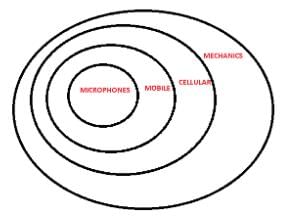
From the venn diagram it is clear that
all microphones are possible to be mechanic and Some microphones are cellular.

Statements :All pencils are pens.Some pens are stickers.All stickers are numbers.Some number are erasers.Q. Conclusions :(i) Some numbers are pens.(ii) Some numbers are stickers.- a)if only conclusion I follows;
- b)if only conclusion II follows;
- c)if either I or II follows;
- d)if neither I nor II follows; and
- e)if both I and II follow
Correct answer is option 'E'. Can you explain this answer?
Statements :
All pencils are pens.
Some pens are stickers.
All stickers are numbers.
Some number are erasers.
Q. Conclusions :
(i) Some numbers are pens.
(ii) Some numbers are stickers.
a)
if only conclusion I follows;
b)
if only conclusion II follows;
c)
if either I or II follows;
d)
if neither I nor II follows; and
e)
if both I and II follow
|
|
Anaya Patel answered |
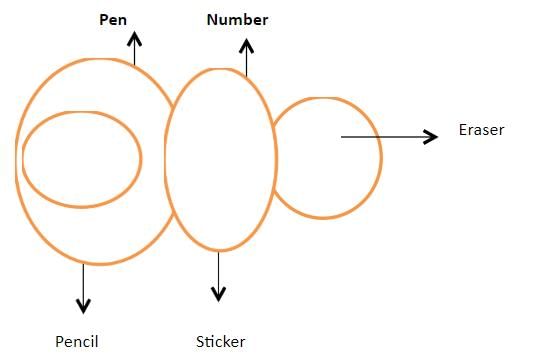
In this question six statements are followed by four answer choices. Each of the answer choices has a combination of three statements from the given statements. You are required to identify the answer choice in which the given statements are logically related and the third statement is a conclusion derived from the first two statements.Q.
A. All mechanics are controllable.B. All mechanics are definable.C. All devices need contraptions.D. All mechanics need instruments.E. All devices need instruments.F. All mechanics are devices.- a)FEC
- b)FEA
- c)FEB
- d)FED
Correct answer is option 'C'. Can you explain this answer?
In this question six statements are followed by four answer choices. Each of the answer choices has a combination of three statements from the given statements. You are required to identify the answer choice in which the given statements are logically related and the third statement is a conclusion derived from the first two statements.
Q.
A. All mechanics are controllable.
A. All mechanics are controllable.
B. All mechanics are definable.
C. All devices need contraptions.
D. All mechanics need instruments.
E. All devices need instruments.
F. All mechanics are devices.
a)
FEC
b)
FEA
c)
FEB
d)
FED
|
|
Hari Omm answered |
'D'
In each of the questions below are given three statements followed by three or more conclusions. You have to take the given statements to be true even if they seem to be at variance with the commonly known facts.Statements:All desks are benches.
No bench is chair.
All chairs are roads.Conclusions:I. Some roads are chairs.II. No chair is desk.III. No road is bench.IV. Some desks are roads.- a)All follow
- b)Only I and II follows.
- c)Only II follows.
- d)Only either I or III and II follow
Correct answer is option 'B'. Can you explain this answer?
In each of the questions below are given three statements followed by three or more conclusions. You have to take the given statements to be true even if they seem to be at variance with the commonly known facts.
Statements:
All desks are benches.
No bench is chair.
All chairs are roads.
No bench is chair.
All chairs are roads.
Conclusions:
I. Some roads are chairs.
II. No chair is desk.
III. No road is bench.
IV. Some desks are roads.
a)
All follow
b)
Only I and II follows.
c)
Only II follows.
d)
Only either I or III and II follow
|
|
Faizan Khan answered |
B is the correct option as I and II follow the statement. III and IV don't follow as if all desks are benches and no bench is chair, so none of the chairs can be a desk and also if all chairs are road so some roads can be chairs.
In each of the questions below given four statements followed by three conclusions numbered I, II and III. You have to take the given statements to be true even if they seem to be at variance from commonly known facts. Read all the conclusions and then decide which of the given conclusions logically follows from the given statements disregarding commonly known facts.Q. Statements: Some seeds are flowers. All flowers are trees. All trees are leaves. Some leaves are plantsConclusions:I. Some plants are flowers.II. Some leaves are seeds.III. Some leaves are flowers.- a)I and II follow
- b)I and III follow
- c)II and III follow
- d)All I, II and III follow
- e)None of the above
Correct answer is option 'C'. Can you explain this answer?
In each of the questions below given four statements followed by three conclusions numbered I, II and III. You have to take the given statements to be true even if they seem to be at variance from commonly known facts. Read all the conclusions and then decide which of the given conclusions logically follows from the given statements disregarding commonly known facts.
Q. Statements: Some seeds are flowers. All flowers are trees. All trees are leaves. Some leaves are plants
Conclusions:
I. Some plants are flowers.
II. Some leaves are seeds.
III. Some leaves are flowers.
a)
I and II follow
b)
I and III follow
c)
II and III follow
d)
All I, II and III follow
e)
None of the above
|
|
Kiran Reddy answered |
It is clear from the venn diagram that only conclusion 2 and 3 follows.
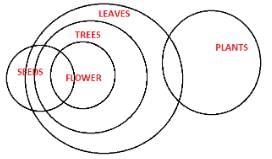

In this question six statements are followed by four answer choices. Each of the answer choices has a combination of three statements from the given statements. You are required to identify the answer choice in which the given statements are logically related and the third statement is a conclusion derived from the first two statements.
Q.
A. Some boats are drawers.
B. Some boats are brown.
C. All drawers are brown.
D. All boats are brown.
E. All brown are boats.
F. Some brown are not boats.
- a)ABC
- b)ACB
- c)FCD
- d)EAC
Correct answer is option 'B'. Can you explain this answer?
In this question six statements are followed by four answer choices. Each of the answer choices has a combination of three statements from the given statements. You are required to identify the answer choice in which the given statements are logically related and the third statement is a conclusion derived from the first two statements.
Q.
A. Some boats are drawers.
A. Some boats are drawers.
B. Some boats are brown.
C. All drawers are brown.
D. All boats are brown.
E. All brown are boats.
F. Some brown are not boats.
a)
ABC
b)
ACB
c)
FCD
d)
EAC
|
|
Aryan Khanna answered |
The correct option is B.
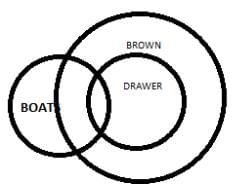
To determine the correct answer, we need to identify the combination of statements in which the third statement is a logical conclusion derived from the first two statements.
Let's evaluate the given options:
-
ABC:
- A. Some boats are drawers.
- B. Some boats are brown.
- C. All drawers are brown.
Conclusion: The third statement (C) does not logically follow from the first two statements. It introduces new information that isn't derived from A and B. This option is incorrect. -
ACB:
- A. Some boats are drawers.
- C. All drawers are brown.
- B. Some boats are brown.
Conclusion: The third statement (B) can logically follow from the first two. If some boats are drawers (A), and all drawers are brown (C), then it follows that some boats could be brown. This option is correct. -
FCD:
- F. Some brown are not boats.
- C. All drawers are brown.
- D. All boats are brown.
Conclusion: The third statement (D) does not logically follow from F and C. There's a contradiction between F and D, making this option incorrect. -
EAC:
- E. All brown are boats.
- A. Some boats are drawers.
- C. All drawers are brown.
Conclusion: The third statement (C) does not logically follow from E and A. C introduces information not logically derived from E and A. This option is incorrect.
Answer: Option B (ACB) is the correct answer because the third statement (B) is logically derived from the first two statements (A and C).
In each of the questions below given four statements followed by three conclusions numbered I, II and III. You have to take the given statements to be true even if they seem to be at variance from commonly known facts. Read all the conclusions and then decide which of the given conclusions logically follows from the given statements disregarding commonly known facts.Q. Statements: All cards are notes. All notes are tyres. All tyres are books. All books are rods.Conclusions: I. Some rods are notes.II. Some books are tyres.III. Some tyres are cards- a)I and II follow
- b)I and III follow
- c)II and III follow
- d)All I, II and III follow
- e)None of the above
Correct answer is option 'D'. Can you explain this answer?
In each of the questions below given four statements followed by three conclusions numbered I, II and III. You have to take the given statements to be true even if they seem to be at variance from commonly known facts. Read all the conclusions and then decide which of the given conclusions logically follows from the given statements disregarding commonly known facts.
Q. Statements: All cards are notes. All notes are tyres. All tyres are books. All books are rods.
Conclusions:
I. Some rods are notes.
II. Some books are tyres.
III. Some tyres are cards
a)
I and II follow
b)
I and III follow
c)
II and III follow
d)
All I, II and III follow
e)
None of the above

|
Kaavya Nair answered |
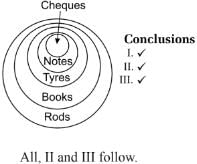
Statements :All dusters are bowls.All bowls are shoes.No shoe is a root.All roots are flowers.Conclusions :(i) No duster is a root.(ii) All flowers are root.- a)if only conclusion I follows;
- b)if only conclusion II follows;
- c)if either I or II follows;
- d)if neither I nor II follows; and
- e)if both I and II follow
Correct answer is option 'A'. Can you explain this answer?
Statements :
All dusters are bowls.
All bowls are shoes.
No shoe is a root.
All roots are flowers.
Conclusions :
(i) No duster is a root.
(ii) All flowers are root.
a)
if only conclusion I follows;
b)
if only conclusion II follows;
c)
if either I or II follows;
d)
if neither I nor II follows; and
e)
if both I and II follow
|
|
Anaya Patel answered |
The correct option is A.
As if all roots are flowers that do not means that all flowers are roots, thus only conclusion 1 follows.
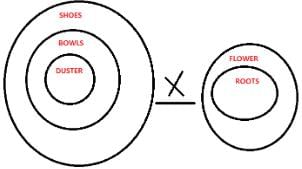
As if all roots are flowers that do not means that all flowers are roots, thus only conclusion 1 follows.

In each of the questions below are given three statements followed by three conclusions numbered I, II and III, You have to take the given statements to be true even if they seem to be at variance from the commonly known facts. Read all the conclusions and then decide which of the given conclusions logically follows from the given statements disregarding commonly known facts.Statements: Some pens are books. All schools are books. Some colleges are schools.Conclusions: - Some colleges are pens.
- Some pens are schools.
- Some colleges are books.
- a)Only I and II follow
- b)Only II and III follow
- c)Only I and III follow
- d)All follow
- e)None of these
Correct answer is option 'E'. Can you explain this answer?
In each of the questions below are given three statements followed by three conclusions numbered I, II and III, You have to take the given statements to be true even if they seem to be at variance from the commonly known facts. Read all the conclusions and then decide which of the given conclusions logically follows from the given statements disregarding commonly known facts.
Statements: Some pens are books. All schools are books. Some colleges are schools.
Conclusions:
- Some colleges are pens.
- Some pens are schools.
- Some colleges are books.
a)
Only I and II follow
b)
Only II and III follow
c)
Only I and III follow
d)
All follow
e)
None of these

|
Pranjal Kapoor answered |
Some pens are books. All schools are books.
Since the middle term 'books' is not distributed even once in the premises, so no definite conclusion follows.
Some colleges are schools. All schools are books.
Since one premise is particular, the conclusion must be particular and should not contain the middle term.
So, it follows that 'Some colleges are books'. Thus, III follows.
Some pens are books. Some colleges are books.
Since both the premises are particular, no definite conclusion can be drawn.
Hence, only III follows.
In this question six statements are followed by four answer choices. Each of the answer choices has a combination of three statements from the given statements. You are required to identify the answer choice in which the given statements are logically related and the third statement is a conclusion derived from the first two statements.Q.
A. All money is lucky.B. Some money is good.C. All money is good.D. Some lucky is money.E. All lucky is good.F. Some lucky is good.- a)BFA
- b)DCA
- c)EFD
- d)ACF
Correct answer is option 'B'. Can you explain this answer?
In this question six statements are followed by four answer choices. Each of the answer choices has a combination of three statements from the given statements. You are required to identify the answer choice in which the given statements are logically related and the third statement is a conclusion derived from the first two statements.
Q.
A. All money is lucky.
A. All money is lucky.
B. Some money is good.
C. All money is good.
D. Some lucky is money.
E. All lucky is good.
F. Some lucky is good.
a)
BFA
b)
DCA
c)
EFD
d)
ACF
|
|
Dia Mehta answered |
The correct option is D.
For clarification refer to the image
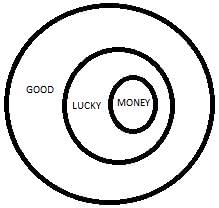
In each of the questions below given four statements followed by three conclusions numbered I, II and III. You have to take the given statements to be true even if they seem to be at variance from commonly known facts. Read all the conclusions and then decide which of the given conclusions logically follows from the given statements disregarding commonly known facts.Q.
Statements:Some Pencils are Chairs. All Chairs are umbrellas. Some umbrellas are sticks. All sticks are caps.Conclusions:I. Some caps are umbrellas.II. Some umbrellas are sticks.III. Some sticks are pencils.- a)I and II follow
- b)I and III follow
- c)II and III follow
- d)All I, II and III follow
- e)None of the above
Correct answer is option 'A'. Can you explain this answer?
In each of the questions below given four statements followed by three conclusions numbered I, II and III. You have to take the given statements to be true even if they seem to be at variance from commonly known facts. Read all the conclusions and then decide which of the given conclusions logically follows from the given statements disregarding commonly known facts.
Q.
Statements:Some Pencils are Chairs. All Chairs are umbrellas. Some umbrellas are sticks. All sticks are caps.
Statements:Some Pencils are Chairs. All Chairs are umbrellas. Some umbrellas are sticks. All sticks are caps.
Conclusions:
I. Some caps are umbrellas.
II. Some umbrellas are sticks.
III. Some sticks are pencils.
a)
I and II follow
b)
I and III follow
c)
II and III follow
d)
All I, II and III follow
e)
None of the above

|
Kumaran Raja answered |
How to identify it
In each of the questions below are given four statements followed by for conclusions numbered I, II, III and IV. You have to the take given statements to be true even if they seem to be at variance from commonly known facts. Read all the conclusions and then decide which of the given conclusion logically follows from the given statements disregarding commonly known facts.
Q.
Statements :
Some mails are chats.
All uploads are chats.
Conclusions :
(i) All mails being uploads is a possibility.
(ii) No upload is a mail.
- a)If only conclusion I follows;
- b)If only conclusion II follows;
- c)If either I or II follows;
- d)If neither I nor II follows; and
- e)If both I and II follow
Correct answer is option 'A'. Can you explain this answer?
In each of the questions below are given four statements followed by for conclusions numbered I, II, III and IV. You have to the take given statements to be true even if they seem to be at variance from commonly known facts. Read all the conclusions and then decide which of the given conclusion logically follows from the given statements disregarding commonly known facts.
Q.
Statements :
Q.
Statements :
Some mails are chats.
All uploads are chats.
Conclusions :
(i) All mails being uploads is a possibility.
(ii) No upload is a mail.
a)
If only conclusion I follows;
b)
If only conclusion II follows;
c)
If either I or II follows;
d)
If neither I nor II follows; and
e)
If both I and II follow

|
Prerna Sen answered |
From the given statements, we can infer that:
- Some chats are mails (from the first statement)
- All uploads are chats (from the second statement)
Using these two statements, we can conclude that:
- Some uploads are mails (since all uploads are chats, and some chats are mails)
Therefore, conclusion I that all mails being uploads is a possibility, logically follows from the given statements.
However, conclusion II that no upload is a mail does not logically follow from the given statements, as we have just shown that some uploads are mails.
Therefore, the correct answer is option 1: If only conclusion I follows.
Directions : In each question below are given two Statements: followed by two conclusion numbered I and II. You have to take the two given statement to be true even if they seem to be at variance with commonly known facts and then decide which of the given Conclusions: logically follows from the two given statement, disregarding commonly know facts.Statements: Some benches are tables. No table is black.Conclusions: I. Some tables are benches. II. No bench is black.- a) if only conclusion I follows;
- b) if only conclusion II follows;
- c) if neither I nor II follows; and
- d) if both I and II follow.
Correct answer is option 'A'. Can you explain this answer?
Directions : In each question below are given two Statements: followed by two conclusion numbered I and II. You have to take the two given statement to be true even if they seem to be at variance with commonly known facts and then decide which of the given Conclusions: logically follows from the two given statement, disregarding commonly know facts.
Statements:
Some benches are tables.
No table is black.
Conclusions:
I. Some tables are benches.
II. No bench is black.
a)
if only conclusion I follows;
b)
if only conclusion II follows;
c)
if neither I nor II follows; and
d)
if both I and II follow.
|
|
Anaya Patel answered |
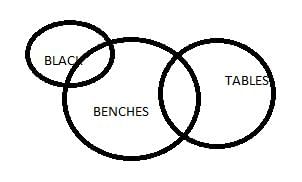 some tables are benches, and some benches or all benches can be black.
some tables are benches, and some benches or all benches can be black.Directions : In each question below are given two Statements: followed by two conclusion numbered I and II. You have to take the two given statement to be true even if they seem to be at variance with commonly known facts and then decide which of the given Conclusions: logically follows from the two given statement, disregarding commonly know facts.Statements:
Some poets are producers.
Some producers are trees.
Conclusions:
I. Some poets are trees.
II. Some trees are producers.
- a)if only conclusion I follows;
- b)if neither I nor II follows; and
- c)if only conclusion II follows;
- d)if both I and II follow
Correct answer is option 'C'. Can you explain this answer?
Directions : In each question below are given two Statements: followed by two conclusion numbered I and II. You have to take the two given statement to be true even if they seem to be at variance with commonly known facts and then decide which of the given Conclusions: logically follows from the two given statement, disregarding commonly know facts.
Statements:
Some poets are producers.
Some producers are trees.
Conclusions:
I. Some poets are trees.
II. Some trees are producers.
a)
if only conclusion I follows;
b)
if neither I nor II follows; and
c)
if only conclusion II follows;
d)
if both I and II follow
|
|
Gaurav Pimpale answered |
I think opt. B is the correct one
Directions : In each question below are given two Statements: followed by two conclusion numbered I and II. You have to take the two given statement to be true even if they seem to be at variance with commonly known facts and then decide which of the given Conclusions: logically follows from the two given statement, disregarding commonly know facts.Statements: All radios are electric goods. All table lamps are electric goods.Conclusions: I. Some radios are table-lamps. II. Some tables-lamps are radios.- a) if only conclusion I follows;
- b) if only conclusion II follows;
- c) if neither I nor II follows; and
- d) if both I and II follow.
Correct answer is option 'C'. Can you explain this answer?
Directions : In each question below are given two Statements: followed by two conclusion numbered I and II. You have to take the two given statement to be true even if they seem to be at variance with commonly known facts and then decide which of the given Conclusions: logically follows from the two given statement, disregarding commonly know facts.
Statements:
All radios are electric goods.
All table lamps are electric goods.
Conclusions:
I. Some radios are table-lamps.
II. Some tables-lamps are radios.
a)
if only conclusion I follows;
b)
if only conclusion II follows;
c)
if neither I nor II follows; and
d)
if both I and II follow.
|
|
Dia Mehta answered |
C is the correct option. Neither of the conclusions follows because If all radios are electric goods and all table lamps are electric goods there is a possibility that radios might overlap table lamps but here the conclusions are SOME radios are table lamps and SOME table lamps are radios which we can not say clearly.
In each of the questions below are given four statements followed by for conclusions numbered I, II, III and IV. You have to the take given statements to be true even if they seem to be at variance from commonly known facts. Read all the conclusions and then decide which of the given conclusion logically follows from the given statements disregarding commonly known facts.Q. Statements: Some benches are walls. All walls are houses. Some houses are jungles. All jungles are windows.Conclusions:I. Some windows are benches.II. Some jungles are walls.III. Some houses are benches.IV. Some windows are houses.- a)I and II follow
- b)I and III follow
- c)III and IV follow
- d)II, III and IV follow
- e)None of the above
Correct answer is option 'C'. Can you explain this answer?
In each of the questions below are given four statements followed by for conclusions numbered I, II, III and IV. You have to the take given statements to be true even if they seem to be at variance from commonly known facts. Read all the conclusions and then decide which of the given conclusion logically follows from the given statements disregarding commonly known facts.
Q. Statements: Some benches are walls. All walls are houses. Some houses are jungles. All jungles are windows.
Conclusions:
I. Some windows are benches.
II. Some jungles are walls.
III. Some houses are benches.
IV. Some windows are houses.
a)
I and II follow
b)
I and III follow
c)
III and IV follow
d)
II, III and IV follow
e)
None of the above
|
|
Dia Mehta answered |
The correct option is C.
The venn diagram for the question is follow-
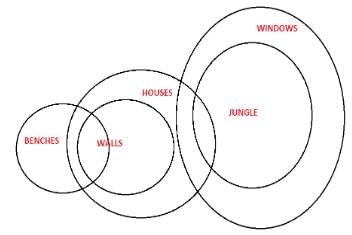
The venn diagram for the question is follow-

In this question six statements are followed by four answer choices. Each of the answer choices has a combination of three statements from the given statements. You are required to identify the answer choice in which the given statements are logically related and the third statement is a conclusion derived from the first two statements.Q.
A. All dancer are silver.B. Some Helen are silver.C. Some dancer may not be Helen.D. Some dancer are Helen.E. All silver are Helen.F. All dancer are Helen.- a)ABD
- b)ABC
- c)FAE
- d)CEA
Correct answer is option 'B'. Can you explain this answer?
In this question six statements are followed by four answer choices. Each of the answer choices has a combination of three statements from the given statements. You are required to identify the answer choice in which the given statements are logically related and the third statement is a conclusion derived from the first two statements.
Q.
A. All dancer are silver.
A. All dancer are silver.
B. Some Helen are silver.
C. Some dancer may not be Helen.
D. Some dancer are Helen.
E. All silver are Helen.
F. All dancer are Helen.
a)
ABD
b)
ABC
c)
FAE
d)
CEA
|
|
Anushka khanna answered |
Logical Reasoning - Syllogisms
Given Statements:
A. All dancer are silver.
B. Some Helen are silver.
C. Some dancer may not be Helen.
D. Some dancer are Helen.
E. All silver are Helen.
F. All dancer are Helen.
Finding the Conclusion:
We need to find the logically related statements and the conclusion derived from them.
Answer Choices:
a) ABD
b) ABC
c) FAE
d) CEA
Option B:
- Statement A: All dancer are silver.
- Statement B: Some Helen are silver.
- Statement C: Some dancer may not be Helen.
Explanation:
- Statement A says that all dancers are silver.
- Statement B says that some Helens are silver.
- Combining these two statements, we can conclude that some dancers are Helens (as they are both silver).
- Statement C says that some dancers may not be Helens. This statement is consistent with the conclusion that we derived from statements A and B. It is possible that some dancers are not Helens, but we know that some are.
- Therefore, option B is the correct answer as it contains logically related statements and a conclusion that can be derived from them.
Conclusion:
The correct answer is option B.
Given Statements:
A. All dancer are silver.
B. Some Helen are silver.
C. Some dancer may not be Helen.
D. Some dancer are Helen.
E. All silver are Helen.
F. All dancer are Helen.
Finding the Conclusion:
We need to find the logically related statements and the conclusion derived from them.
Answer Choices:
a) ABD
b) ABC
c) FAE
d) CEA
Option B:
- Statement A: All dancer are silver.
- Statement B: Some Helen are silver.
- Statement C: Some dancer may not be Helen.
Explanation:
- Statement A says that all dancers are silver.
- Statement B says that some Helens are silver.
- Combining these two statements, we can conclude that some dancers are Helens (as they are both silver).
- Statement C says that some dancers may not be Helens. This statement is consistent with the conclusion that we derived from statements A and B. It is possible that some dancers are not Helens, but we know that some are.
- Therefore, option B is the correct answer as it contains logically related statements and a conclusion that can be derived from them.
Conclusion:
The correct answer is option B.
In this question six statements are followed by four answer choices. Each of the answer choices has a combination of three statements from the given statements. You are required to identify the answer choice in which the given statements are logically related and the third statement is a conclusion derived from the first two statements.Q.
A. Some social Area.B. No Area is radio.C. Some Area may not be social.D. All Area are radio.E. All social are radio.F. Some social are not Area.- a)BEA
- b)EDC
- c)FBE
- d)ABE
Correct answer is option 'B'. Can you explain this answer?
In this question six statements are followed by four answer choices. Each of the answer choices has a combination of three statements from the given statements. You are required to identify the answer choice in which the given statements are logically related and the third statement is a conclusion derived from the first two statements.
Q.
A. Some social Area.
A. Some social Area.
B. No Area is radio.
C. Some Area may not be social.
D. All Area are radio.
E. All social are radio.
F. Some social are not Area.
a)
BEA
b)
EDC
c)
FBE
d)
ABE
|
|
Trisha nayar answered |
Logical Reasoning - Syllogism
Given statements:
A. Some social are Area.
B. No Area is radio.
C. Some Area may not be social.
Answer choices:
A. BEA
B. EDC
C. FBE
D. ABE
In order to identify the answer choice in which the given statements are logically related and the third statement is a conclusion derived from the first two statements, we need to analyze each answer choice.
Option A: BEA
- Some social are radio. (from statement A and E)
- All radio are social. (from statement E)
- Conclusion: Some social are social. (incorrect, as it is redundant)
Option B: EDC
- All social are radio. (from statement E)
- Some Area may not be social. (from statement C)
- Conclusion: No conclusion can be derived from these two statements.
Option C: FBE
- Some social are not Area. (from statement F)
- Some social are radio. (from statement E)
- Conclusion: Some radio are not Area. (incorrect, as it contradicts statement B)
Option D: ABE
- Some social are Area. (from statement A)
- Some social are radio. (from statement E)
- Conclusion: Some Area are not radio. (incorrect, as it contradicts statement B)
Therefore, the correct answer is option B (EDC), as no conclusion can be derived from these two statements.
Given statements:
A. Some social are Area.
B. No Area is radio.
C. Some Area may not be social.
Answer choices:
A. BEA
B. EDC
C. FBE
D. ABE
In order to identify the answer choice in which the given statements are logically related and the third statement is a conclusion derived from the first two statements, we need to analyze each answer choice.
Option A: BEA
- Some social are radio. (from statement A and E)
- All radio are social. (from statement E)
- Conclusion: Some social are social. (incorrect, as it is redundant)
Option B: EDC
- All social are radio. (from statement E)
- Some Area may not be social. (from statement C)
- Conclusion: No conclusion can be derived from these two statements.
Option C: FBE
- Some social are not Area. (from statement F)
- Some social are radio. (from statement E)
- Conclusion: Some radio are not Area. (incorrect, as it contradicts statement B)
Option D: ABE
- Some social are Area. (from statement A)
- Some social are radio. (from statement E)
- Conclusion: Some Area are not radio. (incorrect, as it contradicts statement B)
Therefore, the correct answer is option B (EDC), as no conclusion can be derived from these two statements.
Directions : In each question below are given two Statements: followed by two conclusion numbered I and II. You have to take the two given statement to be true even if they seem to be at variance with commonly known facts and then decide which of the given Conclusions: logically follows from the two given statement, disregarding commonly know facts.Statements: Some curtains are bed sheets. Very few keyboards are curtains.Conclusions: I. Some bed sheets are keyboards. II. No curtains are keyboard.- a) if only conclusion I follows;
- b) if only conclusion II follows;
- c) if neither I nor II follows; and
- d) if both I and II follow.
Correct answer is option 'C'. Can you explain this answer?
Directions : In each question below are given two Statements: followed by two conclusion numbered I and II. You have to take the two given statement to be true even if they seem to be at variance with commonly known facts and then decide which of the given Conclusions: logically follows from the two given statement, disregarding commonly know facts.
Statements:
Some curtains are bed sheets.
Very few keyboards are curtains.
Conclusions:
I. Some bed sheets are keyboards.
II. No curtains are keyboard.
a)
if only conclusion I follows;
b)
if only conclusion II follows;
c)
if neither I nor II follows; and
d)
if both I and II follow.
|
|
Dia Mehta answered |
The correct option is C
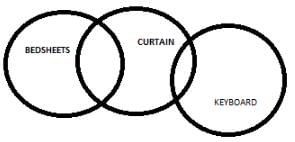

Directions : In each question below are given two Statements: followed by two conclusion numbered I and II. You have to take the two given statement to be true even if they seem to be at variance with commonly known facts and then decide which of the given Conclusions: logically follows from the two given statement, disregarding commonly know facts.Statements: Some hens are cows. All cows are horses.Conclusions: I. Some horses are hens. II. Some hens are horses- a) if only conclusion I follows;
- b) if only conclusion II follows;
- c) if neither I nor II follows; and
- d) if both I and II follow.
Correct answer is option 'D'. Can you explain this answer?
Directions : In each question below are given two Statements: followed by two conclusion numbered I and II. You have to take the two given statement to be true even if they seem to be at variance with commonly known facts and then decide which of the given Conclusions: logically follows from the two given statement, disregarding commonly know facts.
Statements:
Some hens are cows.
All cows are horses.
Conclusions:
I. Some horses are hens.
II. Some hens are horses
a)
if only conclusion I follows;
b)
if only conclusion II follows;
c)
if neither I nor II follows; and
d)
if both I and II follow.
|
|
Anaya Patel answered |
The correct option is D.
Both the conclusions can be drawn from the given statement.
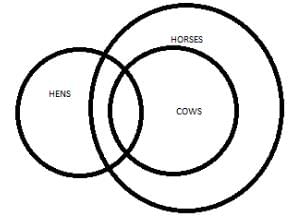
In this question six statements are followed by four answer choices. Each of the answer choices has a combination of three statements from the given statements. You are required to identify the answer choice in which the given statements are logically related and the third statement is a conclusion derived from the first two statements.Q.
A. All black are Rats.B. Some dogs are Rats.C. Some Rats are black.D. All Rats are dogs.E. All dogs are Rats.F. Some dogs are black.- a)CEF
- b)BCF
- c)EFA
- d)ADF
Correct answer is option 'D'. Can you explain this answer?
In this question six statements are followed by four answer choices. Each of the answer choices has a combination of three statements from the given statements. You are required to identify the answer choice in which the given statements are logically related and the third statement is a conclusion derived from the first two statements.
Q.
A. All black are Rats.
A. All black are Rats.
B. Some dogs are Rats.
C. Some Rats are black.
D. All Rats are dogs.
E. All dogs are Rats.
F. Some dogs are black.
a)
CEF
b)
BCF
c)
EFA
d)
ADF
|
|
Anaya Patel answered |
The correct option is D.
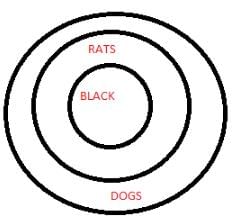

In this question six statements are followed by four answer choices. Each of the answer choices has a combination of three statements from the given statements. You are required to identify the answer choice in which the given statements are logically related and the third statement is a conclusion derived from the first two statements.Q.
A. Some happy are good.B. Some happy are bad.C. No good is bad.D. No happy is good.E. All bad are good.F. Some happy are not bad.- a)ACB
- b)ACF
- c)CED
- d)EFD
Correct answer is option 'B'. Can you explain this answer?
In this question six statements are followed by four answer choices. Each of the answer choices has a combination of three statements from the given statements. You are required to identify the answer choice in which the given statements are logically related and the third statement is a conclusion derived from the first two statements.
Q.
A. Some happy are good.
A. Some happy are good.
B. Some happy are bad.
C. No good is bad.
D. No happy is good.
E. All bad are good.
F. Some happy are not bad.
a)
ACB
b)
ACF
c)
CED
d)
EFD

|
Prashant Sharma answered |
Why not A .
In the questions below are given four statements followed by for conclusions numbered I, II, III and IV. You have to the take given statements to be true even if they seem to be at variance from commonly known facts. Read all the conclusions and then decide which of the given conclusion logically follows from the given statements disregarding commonly known facts.Q.
Statements: Some Clothes are lamps. Some flowers are lamps. Some lamps are dresses. All dresses are shirts.Conclusions:I. Some shirts are ClothesII. Some shirts are flowers.III. Some flowers are Clothes.IV. Some dresses are Clothes.- a)None follows
- b)Only I follows
- c)Only II follows
- d)Only III follows
- e)Only IV follows
Correct answer is option 'A'. Can you explain this answer?
In the questions below are given four statements followed by for conclusions numbered I, II, III and IV. You have to the take given statements to be true even if they seem to be at variance from commonly known facts. Read all the conclusions and then decide which of the given conclusion logically follows from the given statements disregarding commonly known facts.
Q.
Statements: Some Clothes are lamps. Some flowers are lamps. Some lamps are dresses. All dresses are shirts.
Statements: Some Clothes are lamps. Some flowers are lamps. Some lamps are dresses. All dresses are shirts.
Conclusions:
I. Some shirts are Clothes
II. Some shirts are flowers.
III. Some flowers are Clothes.
IV. Some dresses are Clothes.
a)
None follows
b)
Only I follows
c)
Only II follows
d)
Only III follows
e)
Only IV follows
|
|
Anaya Patel answered |
A is the correct option
lamps = some clothes, some flowers and some dresses.
All dresses are shirts, meaning, some lamps are shirts.
lamps = some clothes, some flowers and some dresses.
All dresses are shirts, meaning, some lamps are shirts.
Hence, none of the conclusion is correct.
In this question six statements are followed by four answer choices. Each of the answer choices has a combination of three statements from the given statements. You are required to identify the answer choice in which the given statements are logically related and the third statement is a conclusion derived from the first two statements.Q.
A. Some toes are taps.B. Some taps are hands.C. All toes are taps.D. All toes are hands.E. Some taps are toes.F. Some hands are taps.- a)DEF
- b)ABC
- c)ADC
- d)FDA
Correct answer is option 'A'. Can you explain this answer?
In this question six statements are followed by four answer choices. Each of the answer choices has a combination of three statements from the given statements. You are required to identify the answer choice in which the given statements are logically related and the third statement is a conclusion derived from the first two statements.
Q.
A. Some toes are taps.
A. Some toes are taps.
B. Some taps are hands.
C. All toes are taps.
D. All toes are hands.
E. Some taps are toes.
F. Some hands are taps.
a)
DEF
b)
ABC
c)
ADC
d)
FDA

|
Yogiraj Sadaphal answered |
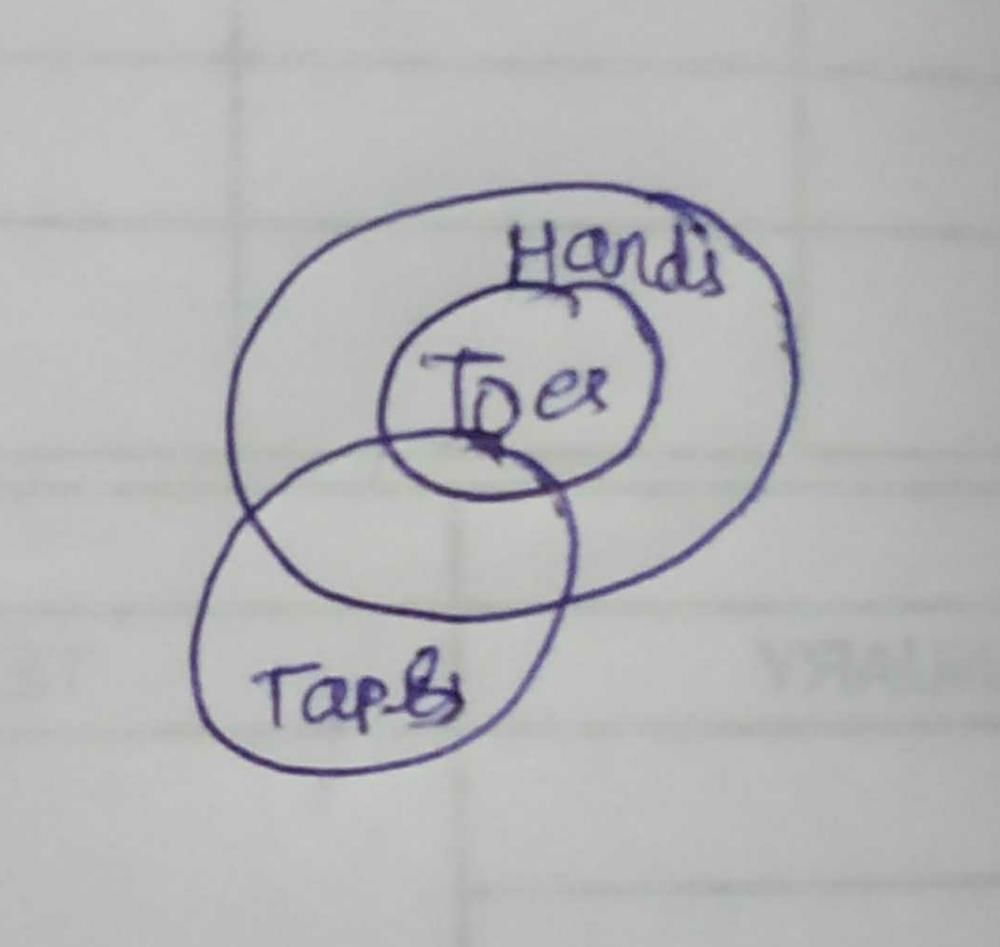
In this question six statements are followed by four answer choices. Each of the answer choices has a combination of three statements from the given statements. You are required to identify the answer choice in which the given statements are logically related and the third statement is a conclusion derived from the first two statements.Q.
A. Some bosses are analytical.B. All analytical bosses are intelligent.C. Mr. Rohit is a boss.D. Mr. Rohit is analytical.E. Mr. Rohit is intelligent.F. All bosses are intelligent.- a)CFE
- b)BCE
- c)DBF
- d)DBE
Correct answer is option 'A'. Can you explain this answer?
In this question six statements are followed by four answer choices. Each of the answer choices has a combination of three statements from the given statements. You are required to identify the answer choice in which the given statements are logically related and the third statement is a conclusion derived from the first two statements.
Q.
A. Some bosses are analytical.
A. Some bosses are analytical.
B. All analytical bosses are intelligent.
C. Mr. Rohit is a boss.
D. Mr. Rohit is analytical.
E. Mr. Rohit is intelligent.
F. All bosses are intelligent.
a)
CFE
b)
BCE
c)
DBF
d)
DBE

|
Chahat Sharma answered |
C
In this question six statements are followed by four answer choices. Each of the answer choices has a combination of three statements from the given statements. You are required to identify the answer choice in which the given statements are logically related and the third statement is a conclusion derived from the first two statements.Q.
A. All Region is hyper.B. All hyper is sad.C. All Region is sad.D. Some hyper is Region.E. Some Region is sad.F. Some hyper is sad.- a)BFA
- b)DCB
- c)EFD
- d)ACF
Correct answer is option 'D'. Can you explain this answer?
In this question six statements are followed by four answer choices. Each of the answer choices has a combination of three statements from the given statements. You are required to identify the answer choice in which the given statements are logically related and the third statement is a conclusion derived from the first two statements.
Q.
A. All Region is hyper.
A. All Region is hyper.
B. All hyper is sad.
C. All Region is sad.
D. Some hyper is Region.
E. Some Region is sad.
F. Some hyper is sad.
a)
BFA
b)
DCB
c)
EFD
d)
ACF

|
Rajendra Advocate answered |
D is the answer
Directions : In each question below are given two Statements: followed by two conclusion numbered I and II. You have to take the two given statement to be true even if they seem to be at variance with commonly known facts and then decide which of the given Conclusions: logically follows from the two given statement, disregarding commonly know facts.Statements: All pendrives are chalks. All chalks are computers.Conclusions: I. All computers are pendrives. II. All pendrives are computers- a) if only conclusion I follows;
- b) if only conclusion II follows;
- c) if neither I nor II follows; and
- d) if both I and II follow.
Correct answer is option 'B'. Can you explain this answer?
Directions : In each question below are given two Statements: followed by two conclusion numbered I and II. You have to take the two given statement to be true even if they seem to be at variance with commonly known facts and then decide which of the given Conclusions: logically follows from the two given statement, disregarding commonly know facts.
Statements:
All pendrives are chalks.
All chalks are computers.
Conclusions:
I. All computers are pendrives.
II. All pendrives are computers
a)
if only conclusion I follows;
b)
if only conclusion II follows;
c)
if neither I nor II follows; and
d)
if both I and II follow.
|
|
Snehal gupta answered |
Given Statements:
- All pendrives are chalks.
- All chalks are computers.
Conclusion I: All computers are pendrives.
Conclusion II: All pendrives are computers.
Explanation:
To find out which conclusions logically follow from the given statements, we need to analyze the statements and determine the relationship between the terms.
Statement 1: All pendrives are chalks.
This statement indicates that every pendrive is a chalk. In other words, the set of pendrives is completely contained within the set of chalks.
Statement 2: All chalks are computers.
This statement indicates that every chalk is a computer. In other words, the set of chalks is completely contained within the set of computers.
Conclusion I: All computers are pendrives.
To evaluate this conclusion, we need to see if it logically follows from the given statements. However, we can clearly see that this conclusion does not logically follow from the given statements. Just because every pendrive is a chalk and every chalk is a computer, it does not mean that every computer is a pendrive. There may be many other objects that fall under the category of computers which are not pendrives. Hence, Conclusion I does not follow.
Conclusion II: All pendrives are computers.
To evaluate this conclusion, we need to see if it logically follows from the given statements. From the given statements, we can see that every pendrive is a chalk and every chalk is a computer. Therefore, it can be inferred that every pendrive is also a computer. This conclusion logically follows from the given statements. Hence, Conclusion II follows.
Conclusion:
Based on the analysis, we can conclude that only Conclusion II (All pendrives are computers) follows from the given statements. Therefore, the correct answer is option b) if only conclusion II follows.
- All pendrives are chalks.
- All chalks are computers.
Conclusion I: All computers are pendrives.
Conclusion II: All pendrives are computers.
Explanation:
To find out which conclusions logically follow from the given statements, we need to analyze the statements and determine the relationship between the terms.
Statement 1: All pendrives are chalks.
This statement indicates that every pendrive is a chalk. In other words, the set of pendrives is completely contained within the set of chalks.
Statement 2: All chalks are computers.
This statement indicates that every chalk is a computer. In other words, the set of chalks is completely contained within the set of computers.
Conclusion I: All computers are pendrives.
To evaluate this conclusion, we need to see if it logically follows from the given statements. However, we can clearly see that this conclusion does not logically follow from the given statements. Just because every pendrive is a chalk and every chalk is a computer, it does not mean that every computer is a pendrive. There may be many other objects that fall under the category of computers which are not pendrives. Hence, Conclusion I does not follow.
Conclusion II: All pendrives are computers.
To evaluate this conclusion, we need to see if it logically follows from the given statements. From the given statements, we can see that every pendrive is a chalk and every chalk is a computer. Therefore, it can be inferred that every pendrive is also a computer. This conclusion logically follows from the given statements. Hence, Conclusion II follows.
Conclusion:
Based on the analysis, we can conclude that only Conclusion II (All pendrives are computers) follows from the given statements. Therefore, the correct answer is option b) if only conclusion II follows.
In each of the questions below are given three statements followed by three or more conclusions. You have to take the given statements to be true even if they seem to be at variance with the commonly known facts.Statements:All markers are black.
All needles are black.
All toys are black.Conclusions:I. Some needles are markers.II. Some toys are markers.III. All markers are toys.IV. All black are markers.- a)All follow
- b)Only either I or III follows.
- c)Only II follows.
- d)None of these
Correct answer is option 'D'. Can you explain this answer?
In each of the questions below are given three statements followed by three or more conclusions. You have to take the given statements to be true even if they seem to be at variance with the commonly known facts.
Statements:
All markers are black.
All needles are black.
All toys are black.
All needles are black.
All toys are black.
Conclusions:
I. Some needles are markers.
II. Some toys are markers.
III. All markers are toys.
IV. All black are markers.
a)
All follow
b)
Only either I or III follows.
c)
Only II follows.
d)
None of these
|
|
Sandeep Shah answered |
The correct answer is D as none of the options given is correct and by drawing the vein diagram .
In each of the questions below given four statements followed by three conclusions numbered I, II and III. You have to take the given statements to be true even if they seem to be at variance from commonly known facts. Read all the conclusions and then decide which of the given conclusions logically follows from the given statements disregarding commonly known facts.Q.
Statements:
Some lenses are poles.
All poles are skies.
Some skies are boxes.
No box is a bottle.Conclusions:I. Some bottles are lensII. Some boxes are poles.III. No bottle is a lens.- a) I and II follows
- b)II and III follows
- c)Only I follows
- d)Only II follows
- e)Only III follows
Correct answer is option 'E'. Can you explain this answer?
In each of the questions below given four statements followed by three conclusions numbered I, II and III. You have to take the given statements to be true even if they seem to be at variance from commonly known facts. Read all the conclusions and then decide which of the given conclusions logically follows from the given statements disregarding commonly known facts.
Q.
Statements:
Some lenses are poles.
All poles are skies.
Some skies are boxes.
No box is a bottle.
Statements:
Some lenses are poles.
All poles are skies.
Some skies are boxes.
No box is a bottle.
Conclusions:
I. Some bottles are lens
II. Some boxes are poles.
III. No bottle is a lens.
a)
I and II follows
b)
II and III follows
c)
Only I follows
d)
Only II follows
e)
Only III follows

|
EduRev CLAT answered |
To solve the problem, we need to analyze the statements and the conclusions based on logical reasoning.
Given Statements:
- Some lenses are poles.
- All poles are skies.
- Some skies are boxes.
- No box is a bottle.
Analysis of Conclusions:
- Conclusion I: Some bottles are lenses.
- This cannot be true since there is no direct relation established between bottles and lenses in the statements. The statements do not imply any relationship between them.
- This cannot be true since there is no direct relation established between bottles and lenses in the statements. The statements do not imply any relationship between them.
- Conclusion II: Some boxes are poles.
- This conclusion does not logically follow. The statements indicate that some skies are boxes and all poles are skies, but this does not mean that boxes can be poles.
- This conclusion does not logically follow. The statements indicate that some skies are boxes and all poles are skies, but this does not mean that boxes can be poles.
- Conclusion III: No bottle is a lens.
- This conclusion follows logically from statement 4 ("No box is a bottle") and statement 1 ("Some lenses are poles"). Since some lenses are poles and no box is a bottle, it suggests that bottles cannot be lenses.
- This conclusion follows logically from statement 4 ("No box is a bottle") and statement 1 ("Some lenses are poles"). Since some lenses are poles and no box is a bottle, it suggests that bottles cannot be lenses.
Final Evaluation:
- Only Conclusion III logically follows.
- Only Conclusion III logically follows.
Thus, the correct answer is e) Only III follows.
In the town of Oakridge, the public library faces budget constraints, prompting a heated debate about resource allocation. The library committee uses logical reasoning to prioritize resources, such as books, digital subscriptions, and community programs, to maximize public benefit. Their decisions rest on categorical statements that form the basis of their strategy, but critics argue that this approach risks overlooking nuanced community needs. Analyzing these statements through syllogistic reasoning is essential to assess the committee’s proposals and their implications.
The committee operates with the following statements: - All children’s programs are essential services.
- All essential services require increased funding.
- Some digital subscriptions are educational resources.
- All educational resources attract young readers.
- Some young readers participate in children’s programs.
These statements create a logical framework. For instance, the committee concludes that children’s programs must receive increased funding due to their essential nature. Critics, however, question whether digital subscriptions, which may also serve young readers, deserve equal priority. The statements suggest a connection between young readers and essential services, raising questions about how to balance funding across resources.
Consider Priya, a committee member, evaluating a proposal: “All children’s programs should receive more funding than digital subscriptions because they directly benefit young readers.” Priya must determine if this proposal logically follows from the statements. Another member, Arjun, argues for prioritizing only resources that attract young readers, prompting debate about whether this aligns with the library’s broader mission to serve all residents. The committee’s reliance on syllogistic reasoning highlights a tension: while logical consistency strengthens their strategy, oversimplification could alienate other community members, such as adult learners. Critics suggest a more flexible approach, but the committee defends its method as transparent and equitable.Which of the following, if true, would weaken Arjun’s suggestion to prioritize only resources that attract young readers?- a)Some digital subscriptions benefit adult learners who are vital to the library’s mission.
- b)All young readers participate in children’s programs.
- c)All educational resources are already fully funded.
- d)No digital subscriptions attract young readers.
Correct answer is option 'A'. Can you explain this answer?
In the town of Oakridge, the public library faces budget constraints, prompting a heated debate about resource allocation. The library committee uses logical reasoning to prioritize resources, such as books, digital subscriptions, and community programs, to maximize public benefit. Their decisions rest on categorical statements that form the basis of their strategy, but critics argue that this approach risks overlooking nuanced community needs. Analyzing these statements through syllogistic reasoning is essential to assess the committee’s proposals and their implications.
The committee operates with the following statements:
- All children’s programs are essential services.
- All essential services require increased funding.
- Some digital subscriptions are educational resources.
- All educational resources attract young readers.
- Some young readers participate in children’s programs.
These statements create a logical framework. For instance, the committee concludes that children’s programs must receive increased funding due to their essential nature. Critics, however, question whether digital subscriptions, which may also serve young readers, deserve equal priority. The statements suggest a connection between young readers and essential services, raising questions about how to balance funding across resources.
Consider Priya, a committee member, evaluating a proposal: “All children’s programs should receive more funding than digital subscriptions because they directly benefit young readers.” Priya must determine if this proposal logically follows from the statements. Another member, Arjun, argues for prioritizing only resources that attract young readers, prompting debate about whether this aligns with the library’s broader mission to serve all residents. The committee’s reliance on syllogistic reasoning highlights a tension: while logical consistency strengthens their strategy, oversimplification could alienate other community members, such as adult learners. Critics suggest a more flexible approach, but the committee defends its method as transparent and equitable.
Which of the following, if true, would weaken Arjun’s suggestion to prioritize only resources that attract young readers?
a)
Some digital subscriptions benefit adult learners who are vital to the library’s mission.
b)
All young readers participate in children’s programs.
c)
All educational resources are already fully funded.
d)
No digital subscriptions attract young readers.

|
EduRev CLAT answered |
Arjun’s suggestion focuses on resources attracting young readers. If digital subscriptions benefit adult learners vital to the library’s mission (a), prioritizing only young reader-focused resources could neglect broader community needs, weakening Arjun’s suggestion. Other options support or are irrelevant to his focus.
Directions : In each question below are given two Statements: followed by two conclusion numbered I and II. You have to take the two given statement to be true even if they seem to be at variance with commonly known facts and then decide which of the given Conclusions: logically follows from the two given statement, disregarding commonly know facts.Statements: All roads are poles. No pole is a house.Conclusions: I. Some roads are houses II. Some houses are poles.- a) if only conclusion I follows;
- b) if only conclusion II follows;
- c) if neither I nor II follows; and
- d) if both I and II follow.
Correct answer is option 'C'. Can you explain this answer?
Directions : In each question below are given two Statements: followed by two conclusion numbered I and II. You have to take the two given statement to be true even if they seem to be at variance with commonly known facts and then decide which of the given Conclusions: logically follows from the two given statement, disregarding commonly know facts.
Statements:
All roads are poles.
No pole is a house.
Conclusions:
I. Some roads are houses
II. Some houses are poles.
a)
if only conclusion I follows;
b)
if only conclusion II follows;
c)
if neither I nor II follows; and
d)
if both I and II follow.

|
Priyanshu Raj answered |
C ho sakta hai
In the town of Oakridge, the public library faces budget constraints, prompting a heated debate about resource allocation. The library committee uses logical reasoning to prioritize resources, such as books, digital subscriptions, and community programs, to maximize public benefit. Their decisions rest on categorical statements that form the basis of their strategy, but critics argue that this approach risks overlooking nuanced community needs. Analyzing these statements through syllogistic reasoning is essential to assess the committee’s proposals and their implications.
The committee operates with the following statements: - All children’s programs are essential services.
- All essential services require increased funding.
- Some digital subscriptions are educational resources.
- All educational resources attract young readers.
- Some young readers participate in children’s programs.
These statements create a logical framework. For instance, the committee concludes that children’s programs must receive increased funding due to their essential nature. Critics, however, question whether digital subscriptions, which may also serve young readers, deserve equal priority. The statements suggest a connection between young readers and essential services, raising questions about how to balance funding across resources.
Consider Priya, a committee member, evaluating a proposal: “All children’s programs should receive more funding than digital subscriptions because they directly benefit young readers.” Priya must determine if this proposal logically follows from the statements. Another member, Arjun, argues for prioritizing only resources that attract young readers, prompting debate about whether this aligns with the library’s broader mission to serve all residents. The committee’s reliance on syllogistic reasoning highlights a tension: while logical consistency strengthens their strategy, oversimplification could alienate other community members, such as adult learners. Critics suggest a more flexible approach, but the committee defends its method as transparent and equitable.Which statement, if true, would strengthen the committee’s argument that all children’s programs require increased funding?- a)Some children’s programs do not attract young readers.
- b)All young readers benefit significantly from children’s programs.
- c)Some digital subscriptions are not educational resources.
- d)All essential services are fully funded.
Correct answer is option 'B'. Can you explain this answer?
In the town of Oakridge, the public library faces budget constraints, prompting a heated debate about resource allocation. The library committee uses logical reasoning to prioritize resources, such as books, digital subscriptions, and community programs, to maximize public benefit. Their decisions rest on categorical statements that form the basis of their strategy, but critics argue that this approach risks overlooking nuanced community needs. Analyzing these statements through syllogistic reasoning is essential to assess the committee’s proposals and their implications.
The committee operates with the following statements:
- All children’s programs are essential services.
- All essential services require increased funding.
- Some digital subscriptions are educational resources.
- All educational resources attract young readers.
- Some young readers participate in children’s programs.
These statements create a logical framework. For instance, the committee concludes that children’s programs must receive increased funding due to their essential nature. Critics, however, question whether digital subscriptions, which may also serve young readers, deserve equal priority. The statements suggest a connection between young readers and essential services, raising questions about how to balance funding across resources.
Consider Priya, a committee member, evaluating a proposal: “All children’s programs should receive more funding than digital subscriptions because they directly benefit young readers.” Priya must determine if this proposal logically follows from the statements. Another member, Arjun, argues for prioritizing only resources that attract young readers, prompting debate about whether this aligns with the library’s broader mission to serve all residents. The committee’s reliance on syllogistic reasoning highlights a tension: while logical consistency strengthens their strategy, oversimplification could alienate other community members, such as adult learners. Critics suggest a more flexible approach, but the committee defends its method as transparent and equitable.
Which statement, if true, would strengthen the committee’s argument that all children’s programs require increased funding?
a)
Some children’s programs do not attract young readers.
b)
All young readers benefit significantly from children’s programs.
c)
Some digital subscriptions are not educational resources.
d)
All essential services are fully funded.

|
Crafty Classes answered |
Statements 1 and 2 establish that children’s programs, as essential services, require increased funding. If all young readers benefit significantly from these programs (b), this strengthens the case for increased funding by emphasizing their impact. Other options weaken or are irrelevant to the argument.
In the town of Oakridge, the public library faces budget constraints, prompting a heated debate about resource allocation. The library committee uses logical reasoning to prioritize resources, such as books, digital subscriptions, and community programs, to maximize public benefit. Their decisions rest on categorical statements that form the basis of their strategy, but critics argue that this approach risks overlooking nuanced community needs. Analyzing these statements through syllogistic reasoning is essential to assess the committee’s proposals and their implications.
The committee operates with the following statements: - All children’s programs are essential services.
- All essential services require increased funding.
- Some digital subscriptions are educational resources.
- All educational resources attract young readers.
- Some young readers participate in children’s programs.
These statements create a logical framework. For instance, the committee concludes that children’s programs must receive increased funding due to their essential nature. Critics, however, question whether digital subscriptions, which may also serve young readers, deserve equal priority. The statements suggest a connection between young readers and essential services, raising questions about how to balance funding across resources.
Consider Priya, a committee member, evaluating a proposal: “All children’s programs should receive more funding than digital subscriptions because they directly benefit young readers.” Priya must determine if this proposal logically follows from the statements. Another member, Arjun, argues for prioritizing only resources that attract young readers, prompting debate about whether this aligns with the library’s broader mission to serve all residents. The committee’s reliance on syllogistic reasoning highlights a tension: while logical consistency strengthens their strategy, oversimplification could alienate other community members, such as adult learners. Critics suggest a more flexible approach, but the committee defends its method as transparent and equitable.Based on the given statements, which conclusion logically follows?- a)All digital subscriptions attract young readers.
- b)Some children’s programs are educational resources.
- c)Some young readers benefit from essential services.
- d)No digital subscriptions are essential services.
Correct answer is option 'C'. Can you explain this answer?
In the town of Oakridge, the public library faces budget constraints, prompting a heated debate about resource allocation. The library committee uses logical reasoning to prioritize resources, such as books, digital subscriptions, and community programs, to maximize public benefit. Their decisions rest on categorical statements that form the basis of their strategy, but critics argue that this approach risks overlooking nuanced community needs. Analyzing these statements through syllogistic reasoning is essential to assess the committee’s proposals and their implications.
The committee operates with the following statements:
- All children’s programs are essential services.
- All essential services require increased funding.
- Some digital subscriptions are educational resources.
- All educational resources attract young readers.
- Some young readers participate in children’s programs.
These statements create a logical framework. For instance, the committee concludes that children’s programs must receive increased funding due to their essential nature. Critics, however, question whether digital subscriptions, which may also serve young readers, deserve equal priority. The statements suggest a connection between young readers and essential services, raising questions about how to balance funding across resources.
Consider Priya, a committee member, evaluating a proposal: “All children’s programs should receive more funding than digital subscriptions because they directly benefit young readers.” Priya must determine if this proposal logically follows from the statements. Another member, Arjun, argues for prioritizing only resources that attract young readers, prompting debate about whether this aligns with the library’s broader mission to serve all residents. The committee’s reliance on syllogistic reasoning highlights a tension: while logical consistency strengthens their strategy, oversimplification could alienate other community members, such as adult learners. Critics suggest a more flexible approach, but the committee defends its method as transparent and equitable.
Based on the given statements, which conclusion logically follows?
a)
All digital subscriptions attract young readers.
b)
Some children’s programs are educational resources.
c)
Some young readers benefit from essential services.
d)
No digital subscriptions are essential services.

|
Crafty Classes answered |
Statement 5 (“Some young readers participate in children’s programs”) and Statement 1 (“All children’s programs are essential services”) imply that some young readers participate in essential services, making c valid. Option a is incorrect (only some digital subscriptions are educational, per Statement 3); b is not supported (no link between children’s programs and educational resources); d is not supported (no statement rules out digital subscriptions as essential).
In this question six statements are followed by four answer choices. Each of the answer choices has a combination of three statements from the given statements. You are required to identify the answer choice in which the given statements are logically related and the third statement is a conclusion derived from the first two statements.Q.
A. Some blue are tree.B. Some paper are not blue.C. All tree are paper.D. Some blue are paper.E. All paper are blue.F. All blue are paper.- a)ADC
- b)ACD
- c)BCF
- d)EAC
Correct answer is option 'B'. Can you explain this answer?
In this question six statements are followed by four answer choices. Each of the answer choices has a combination of three statements from the given statements. You are required to identify the answer choice in which the given statements are logically related and the third statement is a conclusion derived from the first two statements.
Q.
A. Some blue are tree.
A. Some blue are tree.
B. Some paper are not blue.
C. All tree are paper.
D. Some blue are paper.
E. All paper are blue.
F. All blue are paper.
a)
ADC
b)
ACD
c)
BCF
d)
EAC
|
|
Aryan Khanna answered |
B is the correct option. The ACD all together makes a sensible statement set. A. Some blue are tree. C. All tree are paper. D. Some blue are paper.
In each of the questions below are given four statements followed by for conclusions numbered I, II, III and IV. You have to the take given statements to be true even if they seem to be at variance from commonly known facts. Read all the conclusions and then decide which of the given conclusion logically follows from the given statements disregarding commonly known facts.
Q.
Statements :All guns are parachutes.No parachutes is helicopter.All helicopters are airplanes.Conclusions :(i) No gun is helicopter.(ii) All guns being airplanes is a possibility.- a)If both I and II follow
- b)If only conclusion II follows;
- c)If either I or II follows;
- d)If neither I nor II follows; and
- e)If only conclusion I follows;
Correct answer is option 'E'. Can you explain this answer?
In each of the questions below are given four statements followed by for conclusions numbered I, II, III and IV. You have to the take given statements to be true even if they seem to be at variance from commonly known facts. Read all the conclusions and then decide which of the given conclusion logically follows from the given statements disregarding commonly known facts.
Q.
Statements :
Q.
Statements :
All guns are parachutes.
No parachutes is helicopter.
All helicopters are airplanes.
Conclusions :
(i) No gun is helicopter.
(ii) All guns being airplanes is a possibility.
a)
If both I and II follow
b)
If only conclusion II follows;
c)
If either I or II follows;
d)
If neither I nor II follows; and
e)
If only conclusion I follows;
|
|
Anshul patil answered |
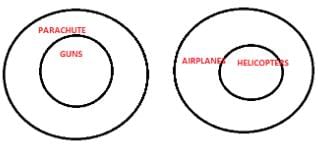
There is no connection between guns and airplanes so conclusion 2 is wrong. Only conclusion 1 is correct
In this question six statements are followed by four answer choices. Each of the answer choices has a combination of three statements from the given statements. You are required to identify the answer choice in which the given statements are logically related and the third statement is a conclusion derived from the first two statements.Q.
A. Some gases is solid.B. All gases is water.C. Some water is gases.D. All water is solid.E. All solid is gases.F. Some water is solid.- a)BAF
- b)FAC
- c)DEB
- d)EFB
Correct answer is option 'A'. Can you explain this answer?
In this question six statements are followed by four answer choices. Each of the answer choices has a combination of three statements from the given statements. You are required to identify the answer choice in which the given statements are logically related and the third statement is a conclusion derived from the first two statements.
Q.
A. Some gases is solid.
A. Some gases is solid.
B. All gases is water.
C. Some water is gases.
D. All water is solid.
E. All solid is gases.
F. Some water is solid.
a)
BAF
b)
FAC
c)
DEB
d)
EFB
|
|
Naveen Banerjee answered |
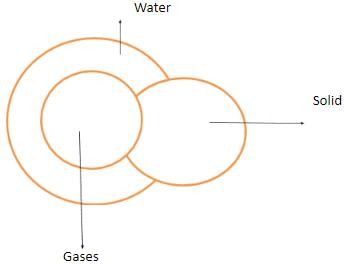
In this question six statements are followed by four answer choices. Each of the answer choices has a combination of three statements from the given statements. You are required to identify the answer choice in which the given statements are logically related and the third statement is a conclusion derived from the first two statements.Q.
A. All mechanics are controllable.B. All mechanics are definable.C. All devices need contraptions.D. All mechanics need instruments.E. All devices need instruments.F. All mechanics are devices.- a)FEC
- b)FEA
- c)FEB
- d)FED
Correct answer is option 'C'. Can you explain this answer?
In this question six statements are followed by four answer choices. Each of the answer choices has a combination of three statements from the given statements. You are required to identify the answer choice in which the given statements are logically related and the third statement is a conclusion derived from the first two statements.
Q.
A. All mechanics are controllable.
A. All mechanics are controllable.
B. All mechanics are definable.
C. All devices need contraptions.
D. All mechanics need instruments.
E. All devices need instruments.
F. All mechanics are devices.
a)
FEC
b)
FEA
c)
FEB
d)
FED
|
|
Nandini iyer answered |
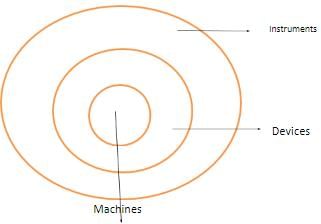
In this question six statements are followed by four answer choices. Each of the answer choices has a combination of three statements from the given statements. You are required to identify the answer choice in which the given statements are logically related and the third statement is a conclusion derived from the first two statements.Q.
A. Some square are round.B. All square are rectangle.C. Some round are rectangle.D. All round are square.E. All rectangle are square.F. Some rectangle are square.- a)CDE
- b)FAB
- c)DCF
- d)EDC
Correct answer is option 'C'. Can you explain this answer?
In this question six statements are followed by four answer choices. Each of the answer choices has a combination of three statements from the given statements. You are required to identify the answer choice in which the given statements are logically related and the third statement is a conclusion derived from the first two statements.
Q.
A. Some square are round.
A. Some square are round.
B. All square are rectangle.
C. Some round are rectangle.
D. All round are square.
E. All rectangle are square.
F. Some rectangle are square.
a)
CDE
b)
FAB
c)
DCF
d)
EDC
|
|
Abhijeet Sen answered |
Statement Analysis:
Let's analyze each statement and find the logical relationships between them.
A. Some square are round.
This statement implies that there exists at least one square that is also round.
B. All square are rectangle.
This statement implies that every square is also a rectangle.
C. Some round are rectangle.
This statement implies that there exists at least one round shape that is also a rectangle.
D. All round are square.
This statement implies that every round shape is also a square.
E. All rectangle are square.
This statement implies that every rectangle is also a square.
F. Some rectangle are square.
This statement implies that there exists at least one rectangle that is also a square.
Logical Relationships:
1. Statement B and E both claim that every square is a rectangle and every rectangle is a square. Therefore, B and E are logically related.
2. Statements A and F both claim the existence of squares that are also round. Therefore, A and F are logically related.
3. Statements C and D both claim the existence of shapes that are both round and rectangle. Therefore, C and D are logically related.
Conclusion:
By analyzing the logical relationships between the statements, we can conclude that:
- Some round are rectangle (Statement C) is a conclusion derived from the first two statements, which are logically related.
Answer:
The answer is option C, which includes statements DCF.
Let's analyze each statement and find the logical relationships between them.
A. Some square are round.
This statement implies that there exists at least one square that is also round.
B. All square are rectangle.
This statement implies that every square is also a rectangle.
C. Some round are rectangle.
This statement implies that there exists at least one round shape that is also a rectangle.
D. All round are square.
This statement implies that every round shape is also a square.
E. All rectangle are square.
This statement implies that every rectangle is also a square.
F. Some rectangle are square.
This statement implies that there exists at least one rectangle that is also a square.
Logical Relationships:
1. Statement B and E both claim that every square is a rectangle and every rectangle is a square. Therefore, B and E are logically related.
2. Statements A and F both claim the existence of squares that are also round. Therefore, A and F are logically related.
3. Statements C and D both claim the existence of shapes that are both round and rectangle. Therefore, C and D are logically related.
Conclusion:
By analyzing the logical relationships between the statements, we can conclude that:
- Some round are rectangle (Statement C) is a conclusion derived from the first two statements, which are logically related.
Answer:
The answer is option C, which includes statements DCF.
In each question six statements are followed by four answer choices. Each of the answer choices has a combination of three statements from the given statements. You are required to identify the answer choice in which the given statements are logically related and the third statement is a conclusion derived from the first two statements. Q. A. Some green is black.B. Some black is green.C, Some sky is black.D. All green is black.E. All black is sky.F. All sky is green.- a)FED
- b)CBD
- c)CFA
- d)ACD
Correct answer is option 'C'. Can you explain this answer?
In each question six statements are followed by four answer choices. Each of the answer choices has a combination of three statements from the given statements. You are required to identify the answer choice in which the given statements are logically related and the third statement is a conclusion derived from the first two statements.
Q. A. Some green is black.
B. Some black is green.
C, Some sky is black.
D. All green is black.
E. All black is sky.
F. All sky is green.
a)
FED
b)
CBD
c)
CFA
d)
ACD
|
|
Gaurav Bana answered |
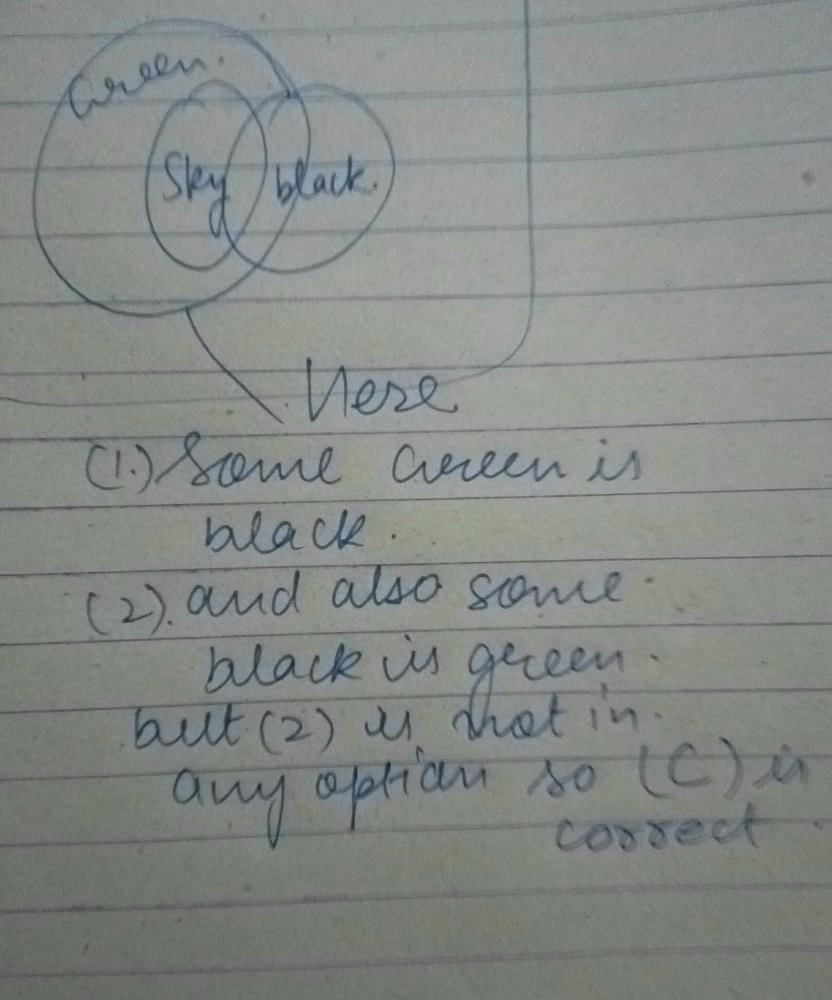
Chapter doubts & questions for Syllogism - 4 Months Preparation Course for CLAT UG 2025 is part of CLAT exam preparation. The chapters have been prepared according to the CLAT exam syllabus. The Chapter doubts & questions, notes, tests & MCQs are made for CLAT 2025 Exam. Find important definitions, questions, notes, meanings, examples, exercises, MCQs and online tests here.
Chapter doubts & questions of Syllogism - 4 Months Preparation Course for CLAT UG in English & Hindi are available as part of CLAT exam.
Download more important topics, notes, lectures and mock test series for CLAT Exam by signing up for free.

Contact Support
Our team is online on weekdays between 10 AM - 7 PM
Typical reply within 3 hours
|
Free Exam Preparation
at your Fingertips!
Access Free Study Material - Test Series, Structured Courses, Free Videos & Study Notes and Prepare for Your Exam With Ease

 Join the 10M+ students on EduRev
Join the 10M+ students on EduRev
|

|
Create your account for free
OR
Forgot Password
OR
Signup on EduRev and stay on top of your study goals
10M+ students crushing their study goals daily









